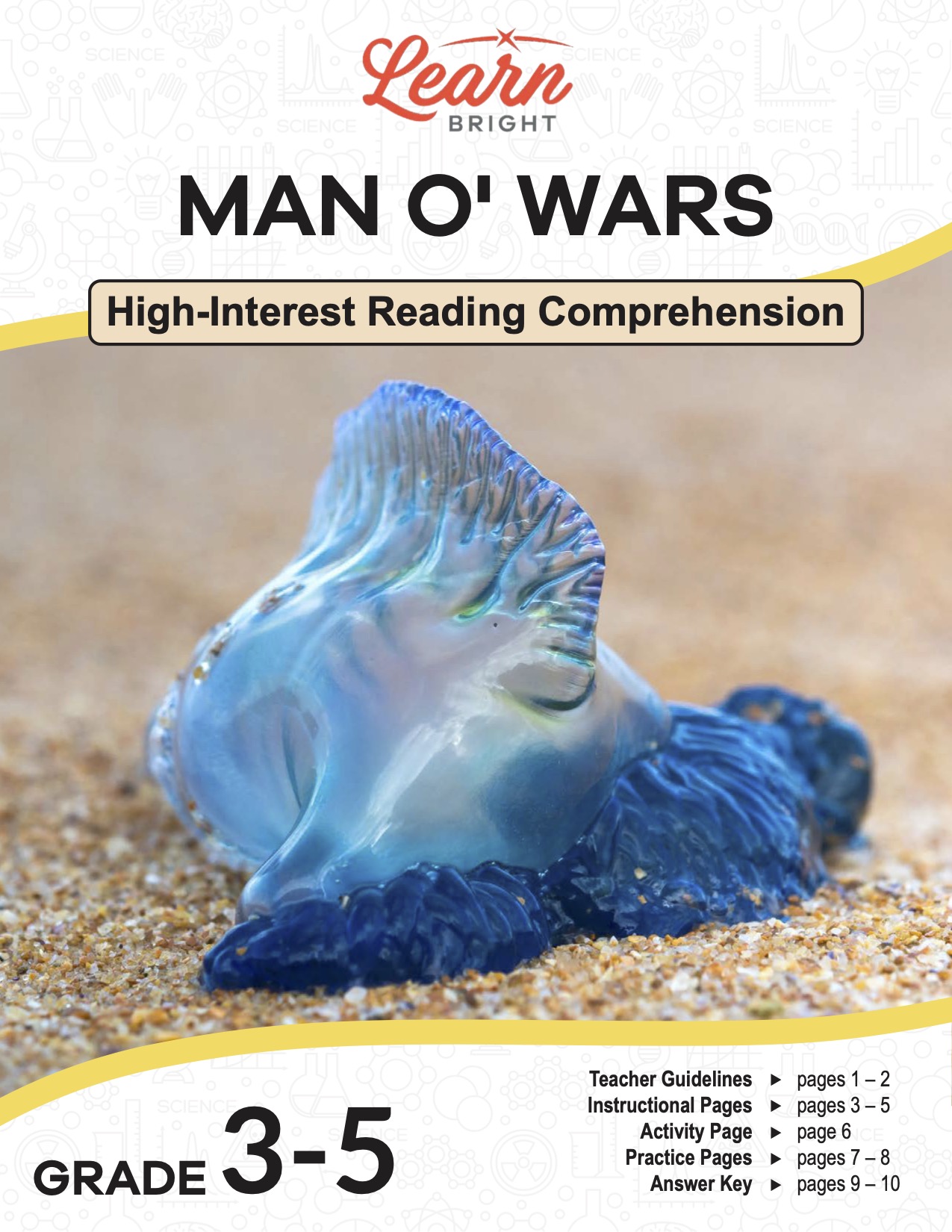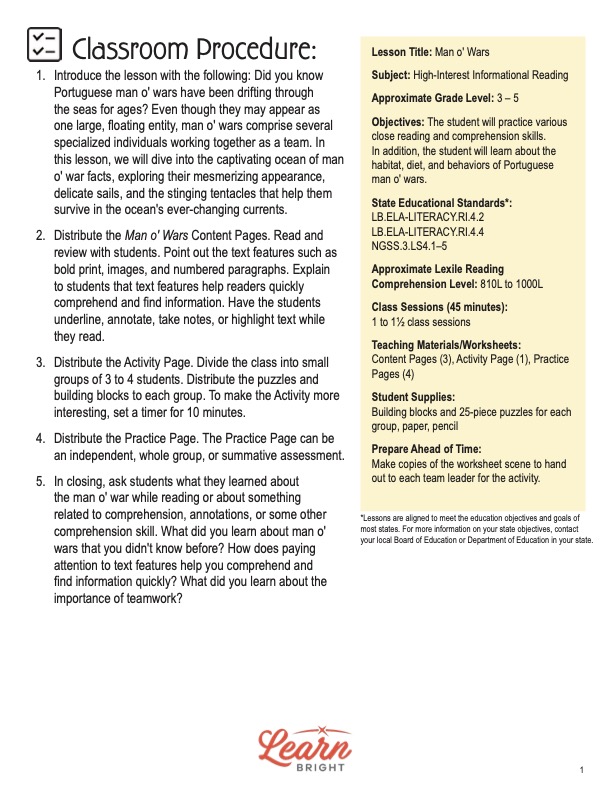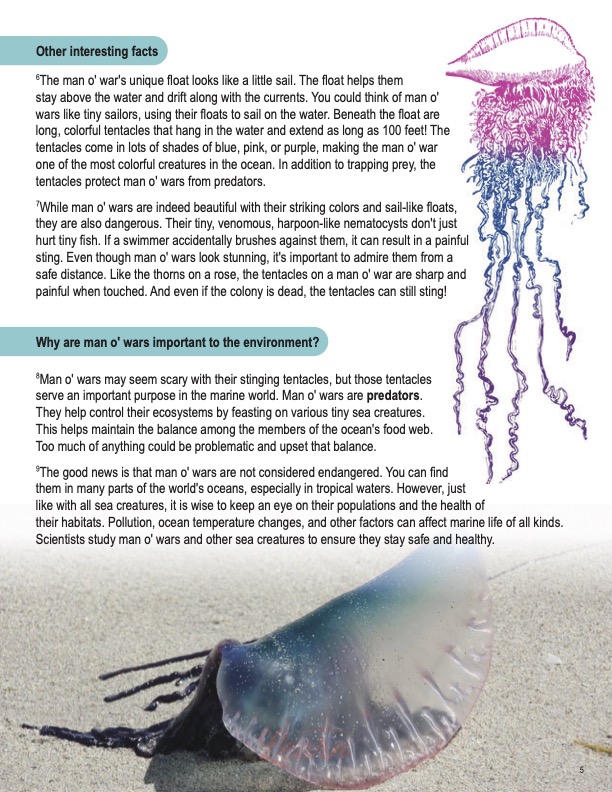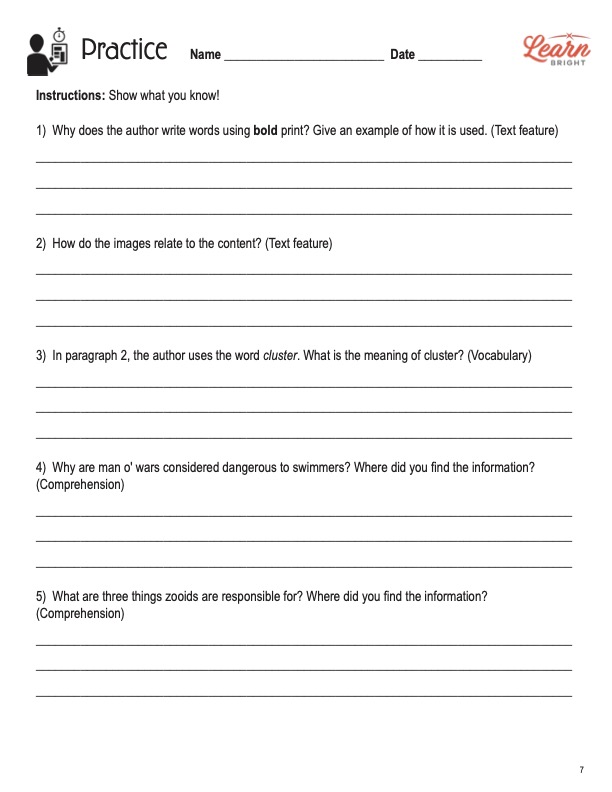Description
What our Man o’ Wars lesson plan includes
Lesson Objectives and Overview: Man o’ Wars is a high-interest reading comprehension lesson plan. As such, students will practice various close reading and comprehension skills. In addition, they will learn about the habitat, diet, and behaviors of man o’ wars. This lesson is for students in 3rd grade, 4th grade, and 5th grade.
Classroom Procedure
Every lesson plan provides you with a classroom procedure page that outlines a step-by-step guide to follow. You do not have to follow the guide exactly. The guide helps you organize the lesson and details when to hand out worksheets. It also lists information in the yellow box that you might find useful. You will find the lesson objectives, state standards, and number of class sessions the lesson should take to complete in this area. In addition, it describes the supplies you will need as well as what and how you need to prepare beforehand. The activity worksheet involves two challenges. All you will need for both challenges are building blocks, a 25-piece puzzle for each group, paper, and pencils.
Teacher Notes
The teacher notes page provides an extra paragraph of information to help guide the lesson. It explains that you can teach this lesson in a whole-class setting or as an independent, small-group activity. You can use the blank lines to write down any other ideas or thoughts you have about the topic as you prepare.
MAN O’ WARS LESSON PLAN CONTENT PAGES
What Is a Man o’ War?
The Man o’ Wars lesson plan contains three content pages. It begins by providing a box of background information about this ocean predator. A man o’ war is a siphonophore. It is not a jellyfish. Man o’ wars mainly live in tropical and subtropical oceans. They feast on crustaceans, small fish, and zooplankton. They only live for about a year.
Man o’ wars, officially known as Portuguese man o’ wars, are fascinating marine creatures with unique physical characteristics. Named after a Portuguese warship, they consist of a gas-filled float that sits above the water like a small sail. This float helps them stay—well—afloat and move around the ocean’s surface. Below the float, they have long, trailing tentacles that look like ribbons. The tentacles are what gives the man o’ war its stinging ability. Despite its appearance, a man o’ war is not a single organism. It’s actually a colony of specialized individuals working together to survive.
These fascinating marine creatures are often found floating on the ocean’s surface. They drift along with ocean currents and live in warm ocean waters, especially in tropical and subtropical regions. Man o’ wars are not generally social animals. They do not form groups the way other animals do—think schools of fish, or pods of dolphins. However, they can sometimes be seen floating in a cluster due to ocean currents and wind patterns. Still, each man o’ war in a cluster remains a separate colony.
A man o’ war reproduces by releasing eggs and sperm into the water. After fertilization, new larvae develop and eventually settle onto a suitable surface. This is where they will grow into the specialized individuals that the colony needs. These individuals, called zooids, are responsible for specific tasks, such as stinging, feeding, and reproducing. But man o’ wars do not care for their young the way many other animals do. Instead, they rely on their unique colony structure and specialized zooids to instinctively survive and thrive in the ocean’s ever-changing environment.
Diet of a Man o’ War
Man o’ wars eat small fish, plankton, and other tiny sea creatures. And they have a distinctive way of catching their food. They don’t use regular mouths and teeth to eat the way humans do. Instead, they have long, trailing tentacles that float in the water. These tentacles are filled with tiny, harpoon-like structures called nematocysts. The nematocysts help trap the prey in the man o’ war’s tentacles. How? Good question!
Catching and eating meals is the responsibility of several zooids in the colony. Some zooids are responsible for capturing food while others help with digestion and floating. When a man o’ war comes across its prey, it uses its nematocysts to capture it. Each nematocyst shoots out a tiny, venomous harpoon, which stings and paralyzes the target. This makes it easier for the man o’ war to bring food to its mouth.
Underneath the float, there are multiple mouths called gastrozooids. The mouths have bag-like stomachs that digest food by releasing enzymes. Enzymes help break down proteins, carbohydrates, and fats into smaller parts for the float to use.
Interesting Facts
The man o’ war’s unique float looks like a little sail. The float helps them stay above the water and drift along with the currents. You could think of man o’ wars like tiny sailors, using their floats to sail on the water. Beneath the float are long, colorful tentacles that hang in the water and extend as long as 100 feet! The tentacles come in lots of shades of blue, pink, or purple, making the man o’ war one of the most colorful creatures in the ocean. In addition to trapping prey, the tentacles protect man o’ wars from predators.
While man o’ wars are indeed beautiful with their striking colors and sail-like floats, they are also dangerous. Their tiny, venomous, harpoon-like nematocysts don’t just hurt tiny fish. If a swimmer accidentally brushes against them, it can result in a painful sting. Even though man o’ wars look stunning, it’s important to admire them from a safe distance. Like the thorns on a rose, the tentacles on a man o’ war are sharp and painful when touched. And even if the colony is dead, the tentacles can still sting!
Why Are Man o’ Wars Important?
Man o’ wars may seem scary with their stinging tentacles, but those tentacles serve an important purpose in the marine world. Man o’ wars are predators. They help control their ecosystems by feasting on various tiny sea creatures. This helps maintain the balance among the members of the ocean’s food web. Too much of anything could be problematic and upset that balance.
The good news is that man o’ wars are not considered endangered. You can find
them in many parts of the world’s oceans, especially in tropical waters. However, just like with all sea creatures, it is wise to keep an eye on their populations and the health of their habitats. Pollution, ocean temperature changes, and other factors can affect marine life of all kinds. Scientists study man o’ wars and other sea creatures to ensure they stay safe and healthy.
MAN O’ WARS LESSON PLAN WORKSHEETS
The Man o’ Wars lesson plan includes two worksheets: an activity worksheet and a practice worksheet. Each one will help students solidify their grasp of the material they learned throughout the lesson. You can refer to the classroom procedure guidelines to know when to hand out each worksheet.
ZOOID TEAMWORK ACTIVITY WORKSHEET
This group activity requires students to work as a team to complete two challenges. First, they will try to build a tower using the object you provide. The rule is they can only use one hand to pick up and place objects. The second challenge requires students to put a puzzle together. For this challenge, there are three rules. Students can only use one hand, cannot speak, and must hand their piece to another player to put into the puzzle. After they finish each challenge, they will answer the questions on the worksheet.
MAN O’ WARS PRACTICE WORKSHEET
The practice worksheet lists 11 questions based on the content. These questions all relate to the content pages, so students will need to refer to them often for the answers. In addition, each question provides which reading tool the question corresponds to, such as text feature, vocabulary, or comprehension.
Worksheet Answer Keys
At the end of the lesson plan document is an answer key for the practice worksheet. The correct answers are all in red to make it easier for you to compare them with students’ responses. If you choose to administer the lesson pages to your students via PDF, you will need to save a new file that omits these pages. Otherwise, you can simply print out the applicable pages and keep these as reference for yourself when grading assignments.










